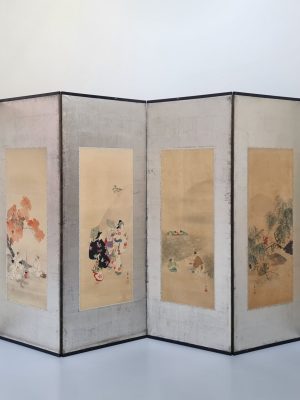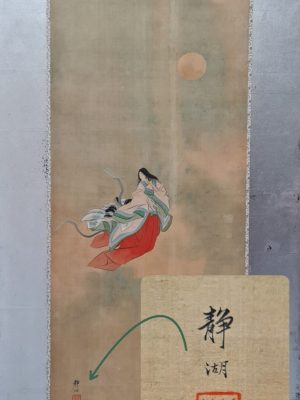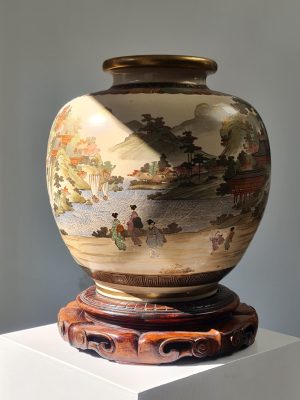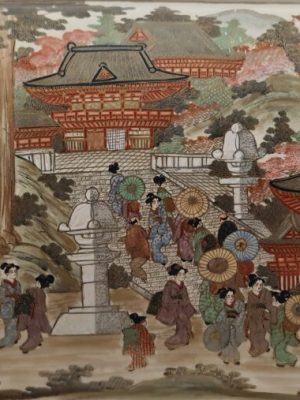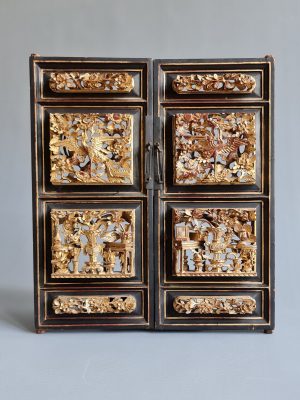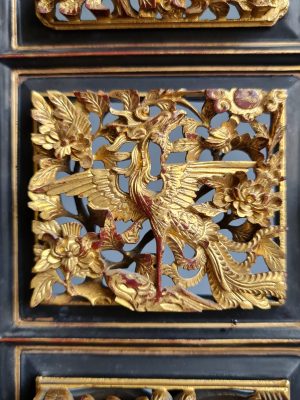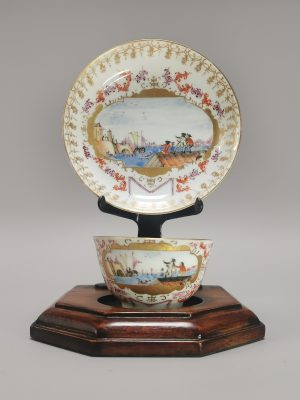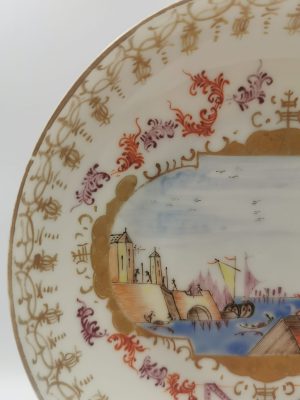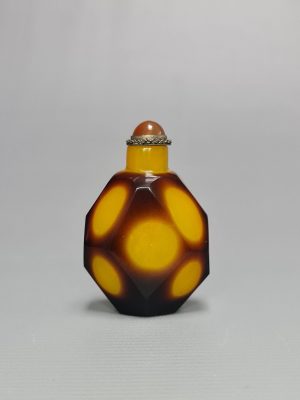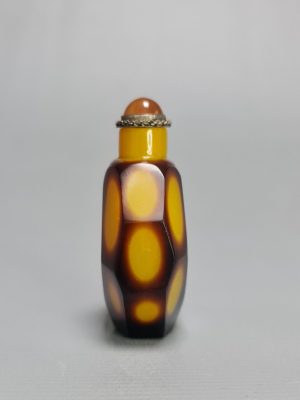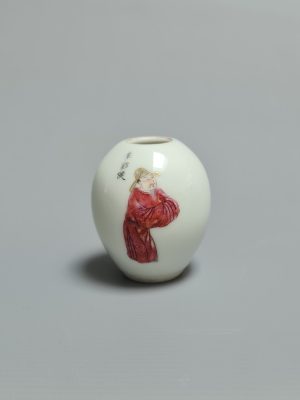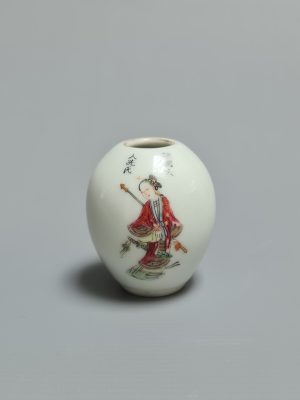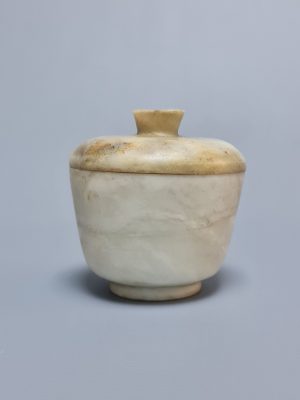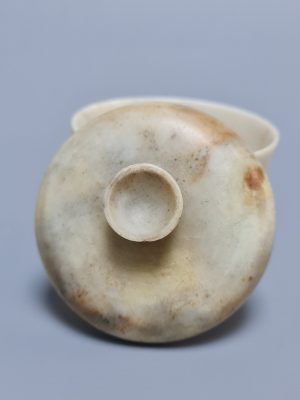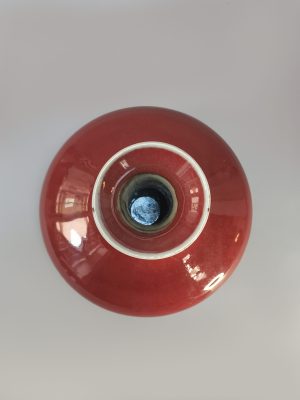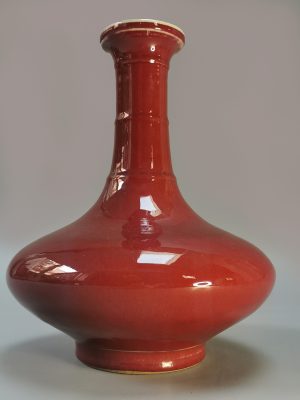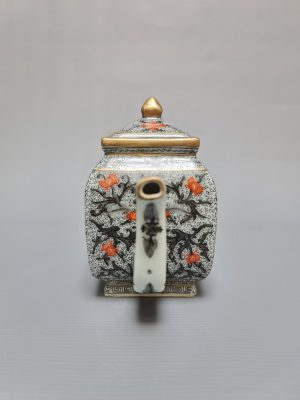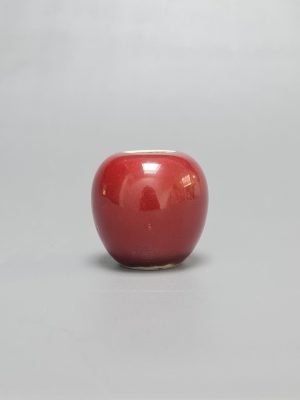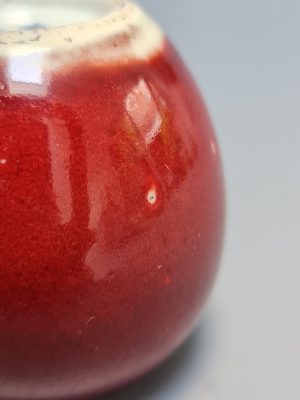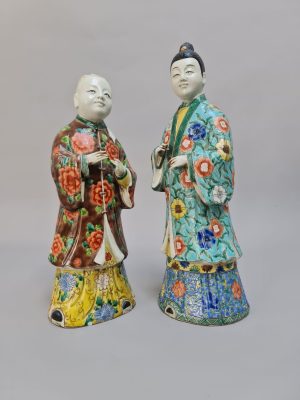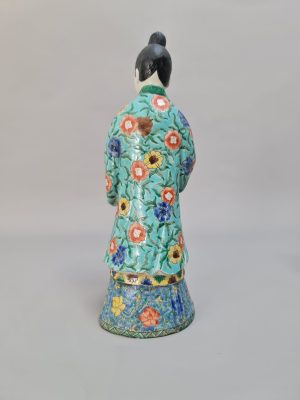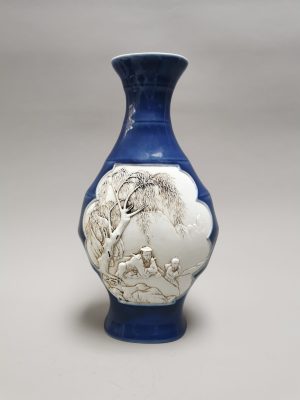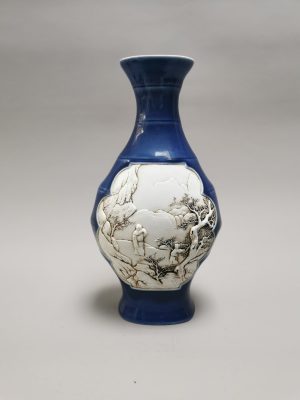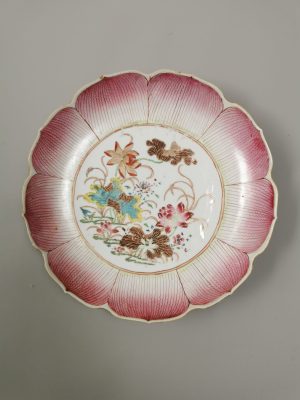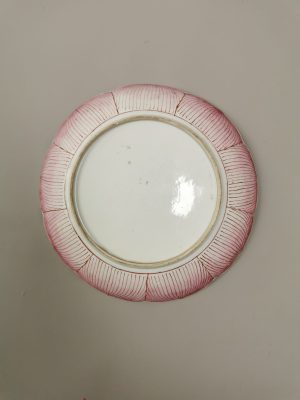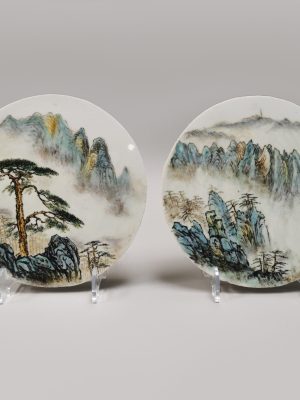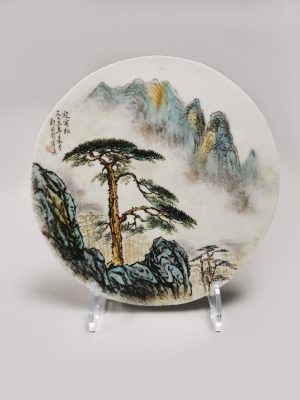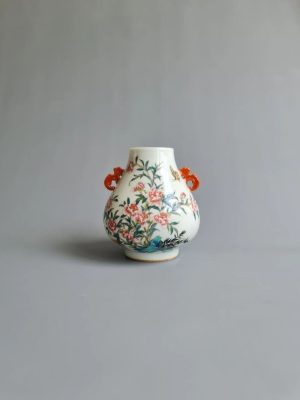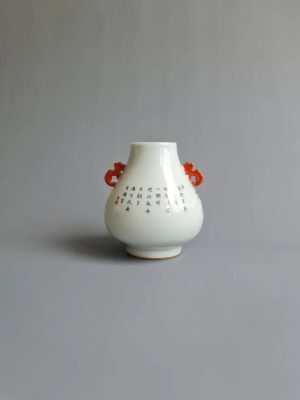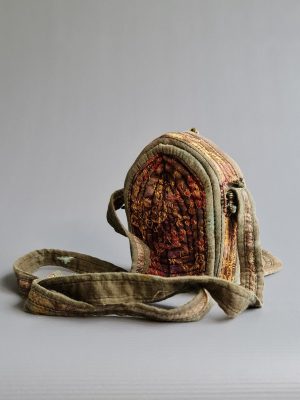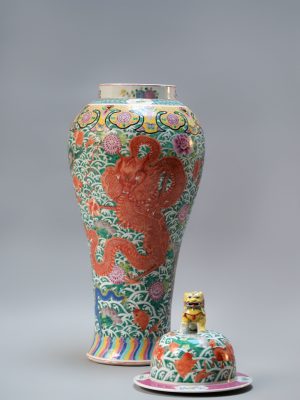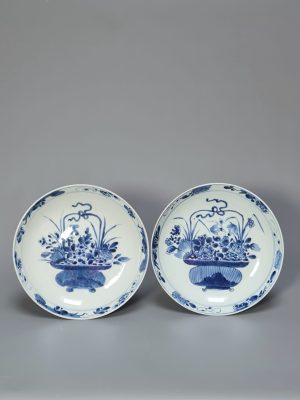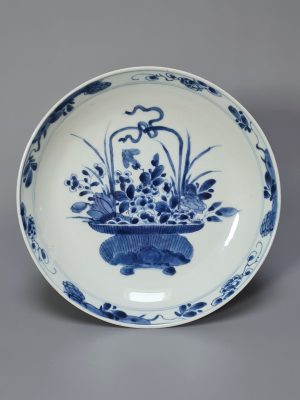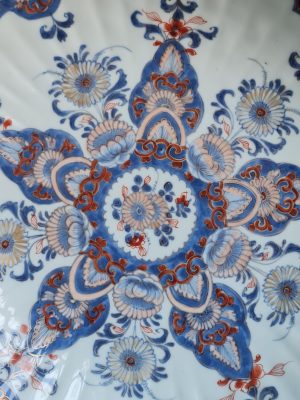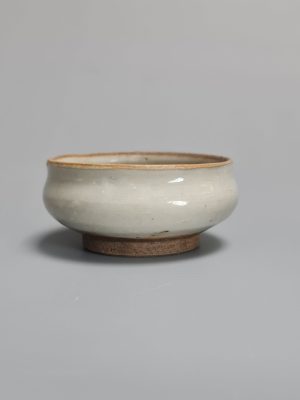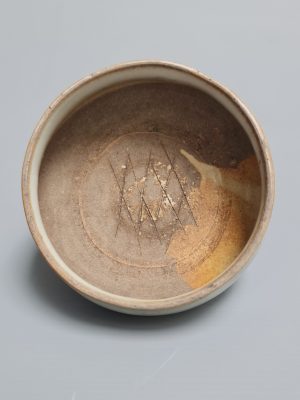-
- Interior, Japanese Art
A large Japanese folding screen with six watercolor paintings
- This is a Japanese multi-panel folding screen with six distinct painted panels, each showcasing traditional scenes of everyday life and landscapes. The artwork, rendered in soft colors, features figures, trees, and various outdoor activities, capturing a serene and nostalgic view of Japanese culture. This type of screen, often used as a room divider or decorative piece, reflects classic Japanese aesthetics…
- Lees verder
-
- Niet op voorraad
- Sold lots
A large Japanese Satsuma vase decorated with figural scenes from court life, Meiji period (1868–1912)
- This large Japanese ceramic Satsuma vase is a remarkable example of craftsmanship from the Meiji period (1868–1912), a time when Japan underwent significant political, cultural, and industrial transformation. The vase is adorned with intricate figural scenes from court life, which was a common subject in Meiji-period Satsuma ware. These scenes often depict noble figures, such as emperors, aristocrats, and samurai,…
- Lees verder
-
-
- Niet op voorraad
- Sold lots
A Pair of Antique Chinese Gilt Wood Carved Door Panels
- In traditional Chinese architecture, door panels were not merely functional elements but also served as intricate works of art. The process of creating gilt wood carved door panels involved skilled artisans who specialized in woodworking and carving techniques. They would start by selecting high-quality wood, such as cedar or rosewood, known for its durability and fine grain. The chosen wood…
- Lees verder
-
-
- Niet op voorraad
- Sold lots
A rare Chinese export porcelain cup and saucer, Yongzheng period (1722-1735)
- Decorated with pink and gold overglaze enamels, these pieces were crafted specifically for export to the West. The saucer features a central panel adorned with European figures amidst a harbor scene complete with European architecture. A gilded curled border frames the edge of the saucer. Similarly, the tea bowl is adorned with a complementary scene on its back. A comparable…
- Lees verder
-
-
- Niet op voorraad
- Sold lots
A rare Chinese faceted brown and yellow Beijing glass snuff bottle with an agate/silver stopper
- The history of Chinese faceted brown and yellow Beijing glass snuff bottles is intertwined with the tradition of snuff-taking and the artistry of glassmaking in China. During the Qing Dynasty (1644-1912), snuff-taking became popular among the Chinese elite as a social and recreational activity. Snuff bottles served as containers for powdered tobacco, and they were often made from various materials,…
- Lees verder
-
-
- Niet op voorraad
- Sold lots
A rare Chinese Famille Rose porcelain water pot, Daoguang marked and possibly from the period
- This rare Chinese Famille Rose porcelain water pot is a fine example of Qing Dynasty artistry, particularly from the 18th and early 19th centuries. Known for its soft, vibrant colors and intricate overglaze enamels, Famille Rose porcelain was highly prized by the imperial court. Marked with a Daoguang seal, this piece may have been created during the reign of Emperor…
- Lees verder
-
-
- Chinese Art
A rare Chinese hard stone (probably chicken bone jade) “gaiwan” covered tea bowl, 18/19 th century
- Sold at Rob Michiels in 2022 see link: https://www.rm-auctions.com/nl/aziatische-kunst-mei-2022/24190-een-chinese-hardstenen-gaiwan-dekselkom-18-19e-eeuw Originally used during the Ming Dynasty (1368-1644), the gaiwan, meaning "lidded bowl," emerged as a versatile vessel for brewing and drinking tea. Made from various materials such as porcelain, ceramic, and later, hard stone. The use of hard stone for crafting gaiwans became popular during the Qing Dynasty (1644-1912), particularly during…
- Lees verder
-
- Niet op voorraad
- Sold lots
A rare Chinese porcelain ‘Sang de Boeuf’ glaze vase, Yongzheng marked
- "Sang de Boeuf" is a French term that translates to "oxblood" in English. It refers to a distinctive glaze used in Chinese porcelain, characterized by its deep red color resembling the rich hue of ox blood. The glaze was developed during the Ming Dynasty (1368-1644) and reached its peak popularity during the Qing Dynasty (1644-1912). The process of achieving the…
- Lees verder
-
-
- Niet op voorraad
- Sold lots
A rare Chinese porcelain hand-painted teapot with a landscape scene and a red overglaze mark
- Hand-painted porcelain has been a hallmark of Chinese ceramics for centuries, showcasing the skill and creativity of the artisans who meticulously decorated each piece. Landscape scenes were a popular subject matter, often depicting serene natural landscapes, mountainous vistas, or idyllic countryside settings. Teapots have long been an essential part of Chinese culture, used not only for brewing and serving tea…
- Lees verder
-
-
- Niet op voorraad
- Sold lots
A rare Chinese porcelain ruby red water pot, Xuantong marked, period (1909-1912)
- The period of Xuantong, also known as the "Last Emperor," was a tumultuous time in Chinese history. Xuantong, whose reign lasted from 1909 to 1912, was the final ruler of the Qing Dynasty, which had ruled China for over two centuries. During the Xuantong period, China faced internal turmoil, including political instability, social unrest, and economic challenges. The Qing Dynasty…
- Lees verder
-
-
- Niet op voorraad
- Sold lots
A rare Chinese porcelain set of figures, Republic period (1912-1949)
- During the Republic period in China, spanning from 1912 to 1949, the country experienced significant political, social, and cultural transformations. This era marked the end of imperial rule and the establishment of a republican government, leading to a period of experimentation and innovation in various fields, including the arts. Chinese porcelain production during the Republic period was characterized by a…
- Lees verder
-
-
- Niet op voorraad
- Sold lots
A rare Chinese vase shaped like bamboo and carved with drawings on both sides
- This rare Chinese vase is crafted in the shape of bamboo, a symbol of endurance and longevity in Chinese culture. Intricately carved drawings adorn both sides of the vase, showcasing meticulous craftsmanship and attention to detail. The naturalistic depiction of bamboo and other motifs reflects traditional Chinese artistic sensibilities. With its elegant form and intricate carvings, this vase exemplifies the…
- Lees verder
-
-
- Niet op voorraad
- Sold lots
A rare large Famille Rose plate in the shape of a lotus flower, Yongzheng/Qianlong, 18th century
- The term "Famille Rose" refers to a style of Chinese porcelain decoration that emerged during the Qing Dynasty, particularly in the Yongzheng (1722-1735) and Qianlong (1736-1795) periods. Famille Rose, which translates to "pink family" in French, is characterized by its vibrant palette of enamel colors, including shades of pink, purple, green, and yellow. The lotus flower holds great symbolic significance…
- Lees verder
-
-
- Niet op voorraad
- Sold lots
A rare set of Chinese porcelain round Qianjiang Cai plaques hand-painted by artist 邹国钧 Zou Guojun (1913-1996), circa 1970
- Zou Guojun (邹国钧) was a renowned Chinese artist known for his expertise in the Qianjiang Cai (literally "thousand rivers and myriad mountains") style of painting. He was born in 1913 and passed away in 1996. Zou Guojun specialized in traditional Chinese painting, particularly in the meticulous and detailed Qianjiang Cai technique, which originated in the late Qing Dynasty and reached…
- Lees verder
-
-
- Niet op voorraad
- Sold lots
A small Famille Rose ‘hu’ vase with underglaze blue Qianlong mark, 18th century
- A small Famille Rose 'hu' vase with an underglaze blue Qianlong mark represents a remarkable example of Qing Dynasty porcelain craftsmanship. The "hu" shape, with its distinctive bulbous body and narrow neck. The Famille Rose decoration on the vase features delicate floral and figurative motifs rendered in vivid colors. This style was achieved using a combination of overglaze enamel colors,…
- Lees verder
-
-
- Niet op voorraad
- Sold lots
A Tibetan Ghau/Gau travel Shrine from Nepal
- The Tibetan Ghau or Gau travel shrine holds a rich history deeply rooted in Tibetan Buddhist tradition, with its origins tracing back to Nepal, a country known for its craftsmanship in religious artifacts. These portable shrines have been integral to Tibetan Buddhist practice for centuries, serving as personal sanctuaries for travelers and devotees. The Ghau/Gau travel shrine is typically a…
- Lees verder
-
-
- Chinese Art
Large Chinese export porcelain ‘Soldier’ vase decorated with 5 dragons, 20th century
- While the association between "soldier vase" and their sentinel-like appearance seems apparent, the term actually originates from a unique diplomatic transaction, highlighting the European nobility's admiration for Chinese luxury goods during the China Trade Period. Augustus the Strong of Saxony, whose reign spanned from 1694 to 1733, harbored an obsession for Chinese porcelain. In negotiations with Frederick the Great of Prussia…
- Lees verder
-
- Chinese Art
Pair of Chinese Blue and White Porcelain Dishes with Basket of Flowers Design, Kangxi Period (1662–1722)
- A stunning pair of Chinese blue and white porcelain dishes, each intricately decorated with a central basket of flowers motif surrounded by floral sprays. These dishes showcase the artistry of the Kangxi period (1662–1722), celebrated for its refined porcelain and elegant cobalt blue decoration. The finely painted details and balanced composition reflect the exceptional craftsmanship of early Qing Dynasty ceramics.…
- Lees verder
-
- Niet op voorraad
- Sold lots
Rare large Chinese porcelain plate with Imari decoration molded in lotus leaf form and highlighted with gilding, Kangxi period (1662-1722)
- During the Kangxi period (1662-1722), Chinese porcelain artisans created exquisite pieces like this plate, adorned with Imari decoration molded in lotus leaf form. Imari ware, originating from Japan but popularized in China during this period, featured vibrant colors and intricate designs. The lotus leaf motif, symbolizing purity and enlightenment in Chinese culture, adds a touch of elegance to the piece.…
- Lees verder
-
-
- Chinese Art
Small Chinese small bowl, Song Dynasty (960–1279)
- The Song Dynasty (960–1279) was a golden age for Chinese ceramics, marked by its technical advancements and refined aesthetic. This period saw the rise of simple, elegant designs that highlighted natural beauty, often with muted glazes in shades like celadon, white, or light blue. Song potters valued subtlety and form over elaborate decoration, focusing on creating graceful, harmonious shapes. Bowls…
- Lees verder
Winkelen
Dit is waar je door producten in deze winkel kunt bladeren.

